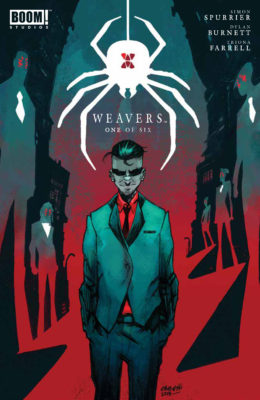
Sid Thyme is in a bit of a spot. The second in command of the Weavers has died and given him her power. Now he’s a Weaver – no choice in the matter. But he’s also curious – a very bad thing to be in a gang of players with powers (even if he’s inherited the power of one of the gang’s heaviest hitters).
Weavers #1 is in stores now. Follow the jump for my review.
Weavers – written by Simon Spurrier (Judge Dredd, X-Force) and drawn by Dylan Burnett (Heavy Metal: Interceptor) – is set in a world in which there are a limited number of people who have some kind of power. The thing is, the power is derived from a kind of ghost spider that forces itself down the throat of its vessel.
The spiders form a kind of gestalt and their vessels wind up being a kind of gang (think The Godfather by H.P. Lovecraft).
When one of the gang – the second in command and heaviest hitter – is killed in an explosion, her spider finds its way to Sid Thyme. Thyme is an average guy – not too smart; not too good looking; not particularly prepossessing at all. What he does have is curiosity – which has the head of the gang thinking maybe he’s a cop.
The first issue of Weavers sets us up with a bit of a look at how the gang is organized (but not too much – we’re finding out about stuff at the same time Sid is), and introduces some of the series’ characters: The Chief – Mr. Don Harvest, Pneema (head of the gang’s brothels and The Chief’s girl), Ms. Ketter (think prim, proper Mary Poppins as a stone cold supernatural killer) and Frankie, The Chief’s daughter.
She and Sid have been assigned to the task of finding Beatrice Harvest’s killer.
Weavers plays fast and loose with the idea of people gaining superpowers – the hows, whys and even the motivations for using them in specific ways (not to mention influences from one’s backgrounds and the needs of the spiders themselves).
Weavers #1 feeds us a lot of information in the same way Sid learns about his new situation – a huge load of information is dropped on him and he’s expected to figure things out on the go. Spurrier gives his audience the compliment of expecting them to figure stuff out as we go, too – there’s no spoon-feeding here. He just assumes his audience is intelligent.
Dylan Burnett’s art is kind of slash-and-gash. He uses strong, harsh lines in an impressionistic manner. Frank Miller is definitely an influence here, but his layouts suggest something of Jamie Hewlett and even a bit of Tim Burton.
The result is a comic that looks and feels strange and a bit off-putting in a good way. It’s unsettling and sharp; smart and remarkably unfussy.
Final Grade: A